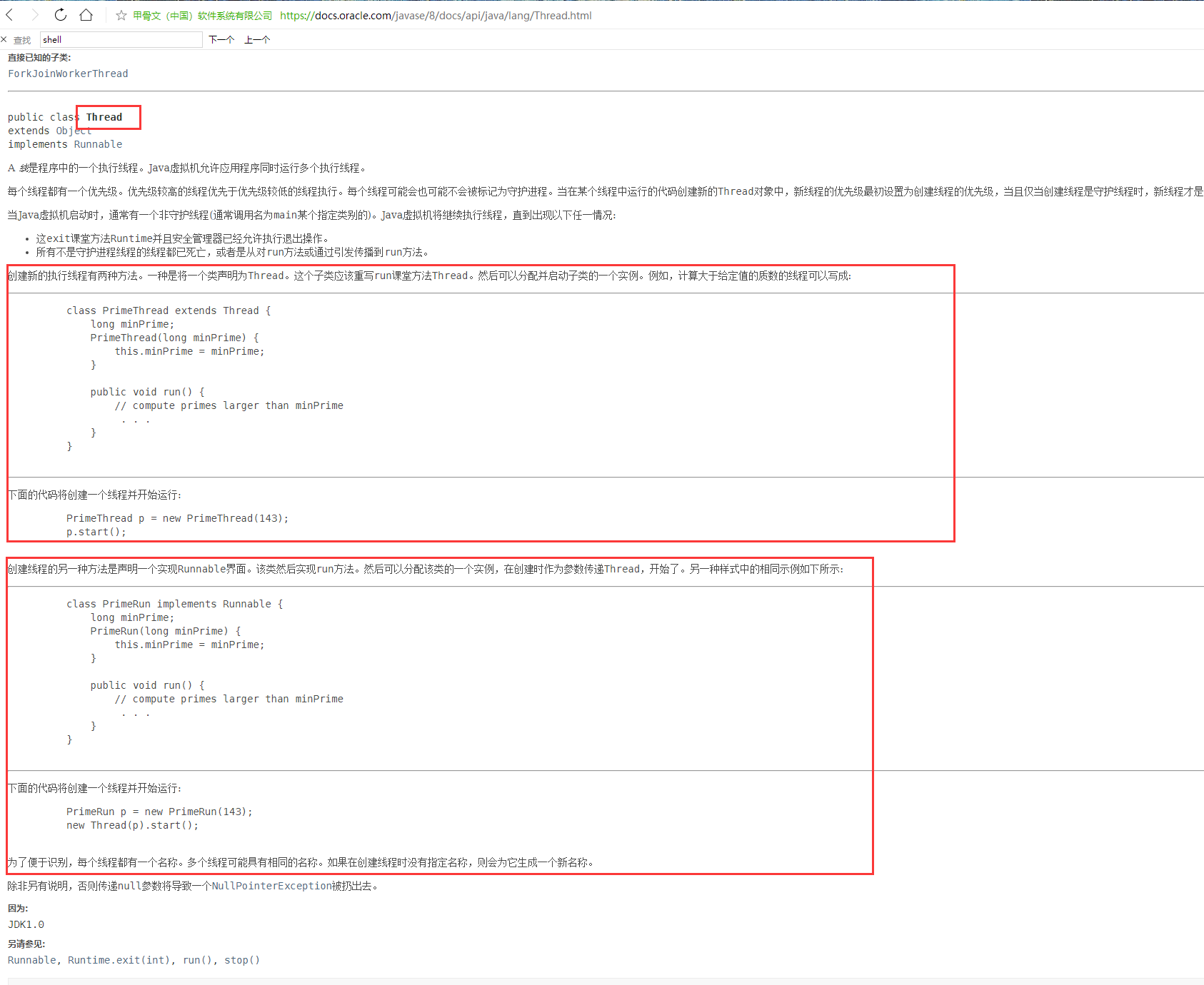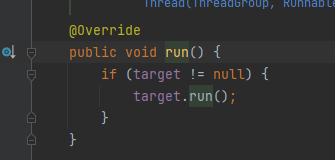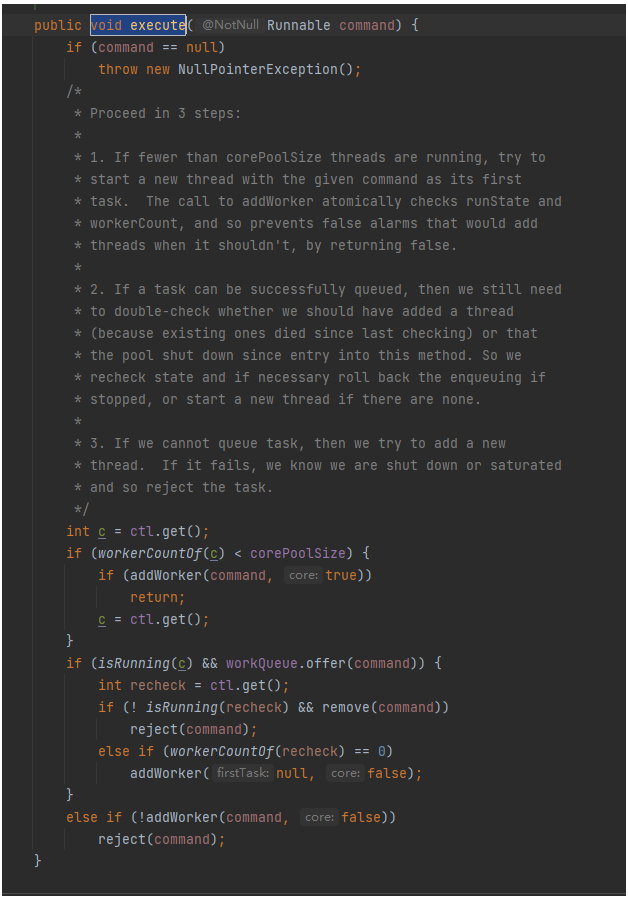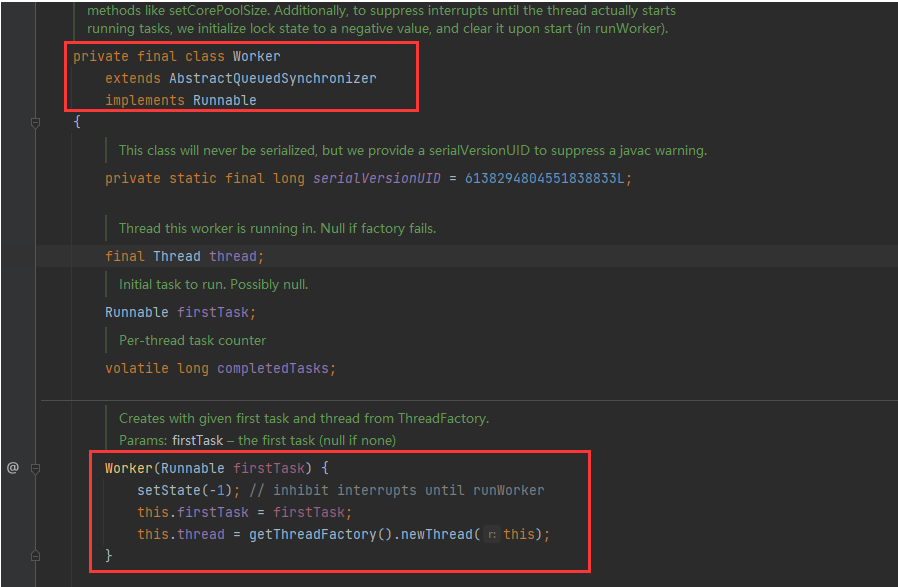Java实现多线程有几种方式(满分回答)
.jpg)
JDK8 创建的线程的两种方式
orcle文档解释
orcle文档:https://docs.oracle.com/javase/8/docs/api/java/lang/Thread.html

总结:
准确的讲,创建线程只有一种方式那就是构造Thread类,而实现线程的执行单元有两种方式:
- 方法一:实现
Runnable接口的重写run方法,并把Runnable实例传给Thread类 - 方法二∶重写
Thread的run方法(继承Thread类)
(其他一些方式,究其根本都是间接的通过上面两种方式创建的)
方式一:继承Thread类
public static void main(String[] args) {System.out.println("主线程运行:" + Thread.currentThread().getName());Task1 task = new Task1();task.start();}static class Task1 extends Thread{@Overridepublic void run() {for (int i = 0; i < 20; i++) {System.out.println("task1线程运行" + Thread.currentThread().getName());System.out.println("Task11继承Thread实现多线程");}}}}
自定义线程类继承Thread类
重写run()方法,编写线程执行体
创建线程对象,调用start()方法启动线程
方式二:实现Runnable接口
public static void main(String[] args) {Task task = new Task();Thread thread = new Thread(task);thread.start();}static class Task implements Runnable{@Overridepublic void run() {for (int i = 0; i < 20; i++) {System.out.println("task1线程运行" + Thread.currentThread().getName());System.out.println("Task11实现Runnable接口实现多线程");}}}
定义MyRunnable类实现Runnable接口
实现run()方法,编写线程执行体
创建线程对象,调用start()方法启动线程
同时用两种的情况
public static void main(String[] args) {new Thread(new Runnable() {@Overridepublic void run() {System.out.println("实现Runnable的run方法");}}){@Overridepublic void run() {System.out.println("匿名内部类,重写Thread类的run方法");}}.run();
}
结果:
匿名内部类,重写Thread类的run方法
分析:
这里使用的匿名内部类,在匿名内部类里面又重写了Thread类的run方法。创建Thread类的同时传入了Runnable对象,这时候Thread类的run已被重写,不再是原生方法的逻辑:执行传入task的run

所以即便传入Runnable,也不会被执行。
其他间接创建方式
Callable接口
public static void main(String[] args) {Task task = new Task();FutureTask<Integer> ft = new FutureTask<>(task);Thread thread = new Thread(ft);thread.start();}static class Task implements Callable<Integer> {@Overridepublic Integer call() throws Exception {for (int i = 0; i < 20; i++) {System.out.println("task1线程运行" + Thread.currentThread().getName());System.out.println("Task11实现Callable接口实现多线程");}return 1;}
}
FutureTask实现了RunnableFuture接口,RunnableFuture继承了Runnable 和 Future接口。所以也是间接通过Runnable来创建的。
- 实现Callable接口,需要返回值类型
- 重写call方法,需要抛出异常
- 创建目标对象
- 创建执行服务:ExecutorService ser = Executors.newFixedThreadPool(1);
- 提交执行:Future result1 = ser.submit(t1);
- 获取结果: boolean r1 = result1.get()
- 关闭服务: ser.shutdownNow();
实现Runnable接口和Callable接口的区别
- Runnable 接口不会返回结果,Callable 接口可以返回结果
- Callable接口实现类中的run方法允许异常向上抛出,可以在内部处理,try catch,但是runnable接口实现类中run方法的异常必须在内部处理,不能抛出
线程池
ThreadPoolExecutor类的execute方法:

public void execute(Runnable command) {if (command == null)throw new NullPointerException();/ Proceed in 3 steps: 1. If fewer than corePoolSize threads are running, try to* start a new thread with the given command as its first* task. The call to addWorker atomically checks runState and* workerCount, and so prevents false alarms that would add* threads when it shouldn't, by returning false. 2. If a task can be successfully queued, then we still need* to double-check whether we should have added a thread* (because existing ones died since last checking) or that* the pool shut down since entry into this method. So we* recheck state and if necessary roll back the enqueuing if* stopped, or start a new thread if there are none. 3. If we cannot queue task, then we try to add a new* thread. If it fails, we know we are shut down or saturated* and so reject the task.*/int c = ctl.get();//如果工作线程数小于核心线程数,if (workerCountOf(c) < corePoolSize) {//执行addWorker,会创建一个核心线程,如果创建失败,重新获取ctlif (addWorker(command, true))return;c = ctl.get();}//如果工作线程数大于等于核心线程数,线程池的状态是RUNNING,并且可以添加进队列//(RUNNING状态下)如果添加失败,说明是队列已经满了,接着就去创建新的线程,如果大于最大线程数,则执行拒绝策略//如果线程池不是RUNNING状态,则执行拒绝策略(当然还会调addWorker进行判断一次)if (isRunning(c) && workQueue.offer(command)) {//再次获取ctl,进行双重检索(也就是对线程池的状态再次检查一遍)int recheck = ctl.get();//如果线程池是不是处于RUNNING的状态,那么就会将任务从队列中移除,//如果移除失败,则会判断工作线程是否为0 ,如果过为0 就创建一个非核心线程//如果移除成功,就执行拒绝策略,因为线程池已经不可用了;if (! isRunning(recheck) && remove(command))reject(command);else if (workerCountOf(recheck) == 0)addWorker(null, false);}else if (!addWorker(command, false))//线程池挂了或者大于最大线程数reject(command);
}
addWork方法会创建线程池内工作线程Worker。Worker这个线程,实现了Runnable接口,并持有一个线程thread,一个初始化的任务firstTask。thread是调用构造方法时通过ThreadFactory来创建的线程

ThreadFactory中也是Runnable创建线程的模式。



